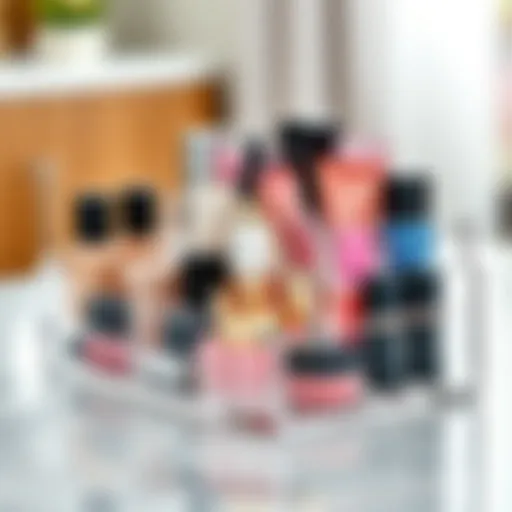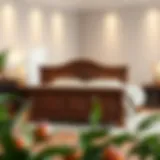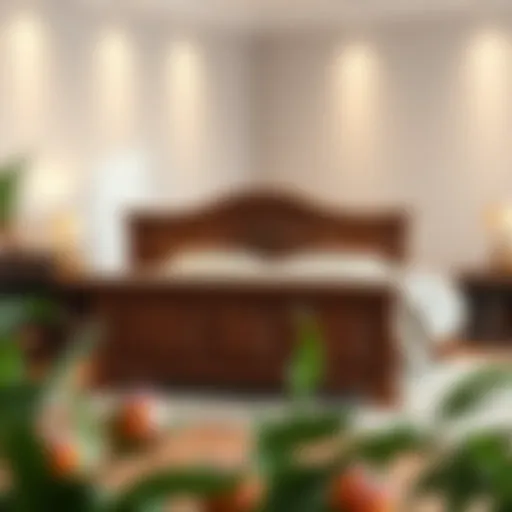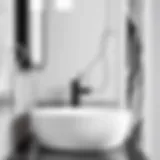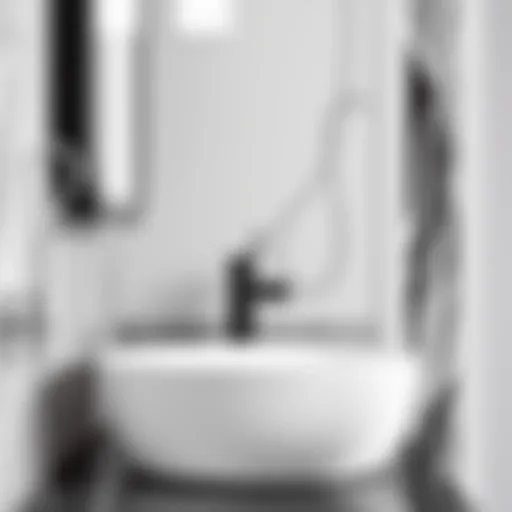Coat Stand: Essential for Home Organization and Style
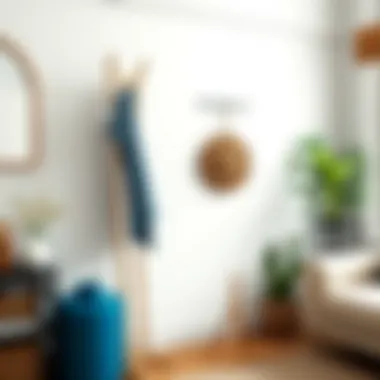

Intro
In the intricate tapestry of home decor, the coat stand often takes a back seat. Yet, this piece of furniture serves as a silent guardian of order in our chaotic lives. Picture it: a sturdy structure, standing tall in an entryway, beckoning us to shed our outer layers and hang our burdens on its hooks. Beyond its primary role of holding coats, it is much more. A well-chosen coat stand can shape the aesthetic of a space while simultaneously promoting organization. This exploration will illuminate its multifaceted significance—from historical nuance to modern design—and guide you on selecting the ideal coat stand that resonates with both your personal aesthetic and functional needs.
Furniture Design Styles
Overview of Popular Styles
Coat stands come in a myriad of designs, each echoing different fashion and functionality. A few popular styles include:
- Minimalist: Clean lines and simplicity define this style. Materials like metal or wood often stripped down to their essence create a striking yet subtle focal point in an entryway.
- Vintage: Rich with nostalgia, vintage coat stands can evoke memories of eras past. Typically made of carved wood, they possess intricate detailing that adds character and charm.
- Contemporary: These stands often feature geometric shapes or innovative designs that serve as an art piece in themselves. They might incorporate mixed materials like glass or acrylic, bringing a modern flair.
- Rustic: Featuring weathered wood and rugged finishes, rustic stands connect to nature. They work particularly well in cabins or homes that embrace natural elements.
How to Mix and Match Styles
While choosing a single style can be appealing, adventurous homeowners might find joy in mixing different styles. To do so effectively:
- Identify Common Themes: Look for elements that connect the disparate styles. This could be color, material, or shape.
- Emphasize Balance: Ensure that one style doesn’t overpower the others. For instance, combine a sleek modern stand with a cozy vintage chair for contrast.
- Use Accessories: Accessorizing with items like art pieces or plants can tie various styles together without overwhelming the overall design.
Practical Tips for Homeowners
Essential Buying Tips
When hunting for that perfect coat stand, keep these guidelines in mind:
- Assess Your Space: Determine the dimensions available in your entryway or hallway; small spaces benefit from vertical designs, while larger areas can accommodate more substantial pieces.
- Consider Functionality: Determine how many coats or bags you typically use. Select a stand that can support weight without wobbling.
- Material Matters: Think about the climate and wear and tear. Metal may rust in humid areas, while untreated wood may warp.
Maintenance and Care Guidelines
To extend the life of your coat stand, regular care is essential:
- Routine Cleaning: Dust and wipe down the stand with a damp cloth to prevent buildup of dirt. For wooden stands, a gentle polish can add shine.
- Check Stability: Periodically tighten screws or brackets if the stand is adjustable.
- Avoid Overloading: Be mindful not to exceed the weight capacity; an overloaded stand can topple and cause damage.
"A coat stand is not just a piece of furniture; it reflects one’s style while promoting order at home."
In closing, a coat stand is an elegant blend of style and practicality. With a keen eye towards design and a few foundational tips in mind, selecting the perfect coat stand becomes an enriching part of the home organization journey. For further insights on furniture design, consider resources from Britannica, or explore contemporary trends on Reddit for the latest user experiences.
The Historical Context of Coat Stands
When considering home organization, the coat stand often slips under the radar. However, understanding its history is crucial for appreciating its role in contemporary design and functionality. Coat stands have evolved from mere conveniences to pivotal pieces of furniture that reflect cultural nuances and aesthetic values. This section takes a closer look at the origins, evolution, and cultural significance of coat stands through time, providing a solid foundation for discerning readers who are interested in design utility and narrative.
Origin and Evolution
The roots of coat stands can be traced back to ancient civilizations, where practicality met artistry. As early as the Roman Empire, hooks were common features in homes, created for hanging cloaks and garments, showcasing human ingenuity for efficient living. These hooks eventually morphed into more elaborate forms as societies progressed, reflecting not only the needs of the individuals but also their social standing.
In the medieval period, coat stands began resembling today's designs, with wooden frames supporting intricate hooks for hanging. Often crafted from oak or walnut, these early stands were more than functional; they were symbols of status. Wealthy families displayed ornate designs, sometimes with carvings that told stories or depicted family crests. As time marched on, the Industrial Revolution spurred an influx of materials and designs, making coat stands accessible to the masses.
By the late 19th century and into the 20th century, coat stands began to adopt a more standardized form. They often integrated elements like umbrella holders and shoe trays, paving the way for multi-functional furniture pieces. Today, coat stands vary in designs, from the curious and avant-garde to the simple and practical, allowing homeowners to choose based on preference and space.
Cultural Significance Through Time
Coat stands symbolize more than just storage; they mirror cultural identity and societal values. In various cultures, they’re seen as the first welcoming gesture in any home. The presence of a coat stand suggests hospitality, inviting guests to remove their outerwear and settle in. In Japan, for example, the kakebuton often serves as a reminder of cleanliness, maintaining a distinction between outside and inside, thus fostering respect for home environments.
In many European countries, coat stands have evolved to reflect architectural styles. A contemporary Scandinavian stand, made of light wood with sleek lines, might underscore minimalism, while a Victorian-style metal stand filled with intricate designs adheres to a celebration of history. Similarly, they can be representative of regional materials and craftsmanship, helping to preserve local traditions.
“A well-chosen coat stand is not just a practical appliance, but a centerpiece that narrates the story of design evolution in your home.”
Whether one opts for a rustic piece with an artisanal flair or a modern, streamlined design, the style often transforms the entryway, setting the tone for the rest of the house. Each model, grand or modest, brings its own character, reinforcing the idea that coat stands are much more than mere items for convenience; they're an essential element of home organization with rich historical roots.
As we delve deeper into design variations, material choices, and functionality of coat stands, a solid understanding of their historical context will aid both designers and homeowners in making informed decisions that honor tradition while embracing modernity.
Design Variations in Coat Stands
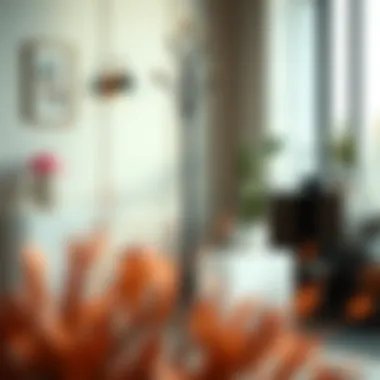

The realm of coat stands is not merely about functionality; it also encapsulates an array of designs reflecting personal style and home aesthetics. With different variations that cater to practical needs while simultaneously enhancing the décor, it's essential to delve into the various designs available. This section will explore minimalist design principles, the timeless appeal of vintage styles, and emerging contemporary trends. By highlighting these variations, readers will gain a broader insight into selecting a coat stand that not only serves its purpose but also resonates with their individual taste.
Minimalist Design Principles
Minimalism thrives on the idea that less is more. Coat stands that embody minimalist design often feature clean lines and simple materials, making them an ideal choice for modern spaces. They blend seamlessly into the background, allowing the overall decor to shine without overwhelming it.
A few characteristic features of minimalist coat stands include:
- Simplicity: These pieces typically forego flashy embellishments or intricate patterns.
- Functional Forms: Shapes like geometric frames or slender poles maximize utility without the fuss.
- Neutral Colors: Often found in shades like white, black, or wood finishes, these stands allow for easy coordination with furniture and walls.
The benefits of minimalist designs include space efficiency. In smaller apartments, where every inch counts, a sleek coat stand can offer convenient storage without hogging valuable room. As the saying goes, "Good things come in small packages," and this is especially true for those who appreciate the balance of aesthetics and functionality.
The Appeal of Vintage Styles
Vintage coat stands bring a rich history to the table. Think of those ornate designs from the late 19th century, crafted of richly colored wood or wrought iron. They possess a certain character that can transform a mundane area into something special. The stylistic traits prominent in vintage coat stands include:
- Intricate Details: Scrolls, carvings, and knobs all embody craftsmanship from a time when furniture was designed with an eye for detail.
- Eclectic Materials: Vintage stands often utilize mixed materials, like wood combined with metal, showcasing both strength and beauty.
- Storytelling Elements: Each vintage piece tells a story, whether it’s a heirloom from a grandparent or a flea market find.
For many, these stands may serve as statement pieces that evoke nostalgia and charm. They are particularly suited for rustic, eclectic, or traditional interiors where they can harmonize with other vintage decor elements.
Contemporary Trends and Innovations
As we move into an era that blends utility with cutting-edge innovation, contemporary coat stands are also evolving. Modern designs incorporate advanced materials and multi-purpose features that mirror today’s lifestyles. Noteworthy trends in this category include:
- Smart Features: Some coat stands now come with tech integrations, such as built-in chargers or LED lighting, making them not only functional but also futuristically appealing.
- Sustainable Materials: With environmental consciousness on the rise, many brands are focusing on eco-friendly materials, ensuring utility while caring for our planet.
- Modular Designs: These are versatile pieces that can adapt to different spaces and needs. They might be adjustable or combinable, allowing users to redefine their coat stand as their needs evolve.
Innovations such as these reflect the ongoing dialogue between tradition and modernity in home design. For anyone aware of current home trends, contemporary coat stands offer a fresh take on storage solutions.
"The beauty of a coat stand lies not only in its design but also in its ability to meld practicality with the spirit of the space."
Ultimately, selecting the right coat stand for your space involves weighing these design variations against your practical needs and aesthetic values, leading to a more organized and visually appealing home.
Materials Commonly Used in Coat Stands
When diving into the world of coat stands, the material chosen can significantly affect not only the aesthetics but also the overall functionality and durability of the piece. The choice of material serves as a narrative thread, weaving through various elements like style and practicality. Moreover, understanding the unique properties of different materials can help designers, retailers, and homeowners make informed decisions that reflect personal taste as well as meet the needs of their spaces.
Wood: Classic and Timeless
Wooden coat stands have held their ground through the ages, embodying a classic charm that resonates with warmth and elegance. The varieties of wood available elevate the design possibilities—be it the rich hues of mahogany or the lighter tones of pine.
One of the undeniable benefits of wood is its ability to blend with a range of interior decors, from rustic to contemporary. Not only that, wooden coat stands tend to exhibit a certain sturdiness; a well-crafted piece can outlast trends and provide longevity in use.
However, there are considerations: wood needs proper care to prevent warping or cracking, especially in environments with fluctuating humidity. Here are some key points about wooden coat stands:
- Natural Insulation: Wood provides a level of insulation from temperature changes.
- Sustainability: When sourced responsibly, wood can be a sustainable choice.
- Customizability: Wood can be stained or painted to match specific design schemes.
"The allure of wood lies not just in its appearance but in its story—each grain tells a tale of nature and craftsmanship."
Metal: Strength and Durability
Metal coat stands often symbolize modernity and strength. They come in various finishes like stainless steel, brass, or wrought iron. Their durability makes them ideal for high-traffic areas where wear and tear are common.
Metal, especially steel, offers unparalleled stability. This is particularly advantageous when supporting heavier items like winter coats or bags. Additionally, the sleek lines and minimalist design often associated with metal can enhance a space's contemporary edge.
However, there are practical aspects to consider. Metal can be susceptible to rust or corrosion if not treated properly, especially in moist environments. Here are a few merits about metal coat stands:
- Easy Maintenance: Most metal surfaces can be easily wiped clean.
- Versatile Designs: Ranging from industrial to artistic, there’s a metal coat stand for every taste.
- High Capacity: Many are designed to hold multiple items without compromising stability.
Combination Materials: Functionality and Style
Combination materials, which meld elements like wood and metal or plastic with wood, can introduce a fresh twist in coat stand design. These hybrids often capitalize on the strengths of each material, rendering a piece that is not only chic but also incredibly functional.
For example, a coat stand with a wooden base and metal hooks provides the warmth of wood contrasting with the modern touch of metal. This variety allows for innovative designs that can fit diverse interior styles while assuring robust functionality.
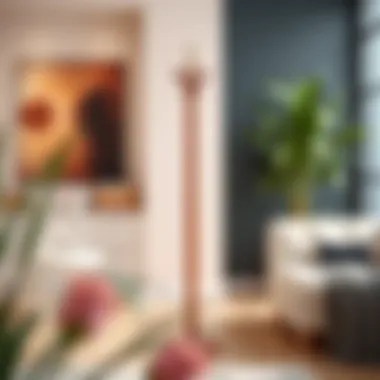

Using combination materials can offer advantages such as:
- Unique Aesthetic: The blend of materials can create an eye-catching focal point.
- Enhanced Durability: Combining materials often yields a product that harnesses the benefits of both, increasing lifespan.
- Cost Effective: Sometimes, using a combination can reduce costs without sacrificing quality.
Understanding the various materials available for coat stands lays a foundation for creating a space that is not only organized but also reflects individual style. Whether it’s the timeless nature of wood, the undeniable strength of metal, or the innovative charm of combinations, each choice plays an essential role in how coat stands function within your home.
Functional Aspects of Coat Stands
When it comes to home organization, coat stands may not often take center stage, yet their functional aspects are pivotal. Not only do they serve as a spot for hanging coats and gear, but they also provide an organized approach to managing daily clutter. By diving into their utility, we can better understand their value in modern homes and how they contribute to a stylish yet functional living space.
Maximizing Space Efficiency
Space can be a premium commodity, especially in urban settings where square footage is at a premium. This is where coat stands shine—they have a unique ability to make the most of vertical space. Instead of piling jackets on chairs or letting them drape over banisters, a coat stand utilizes the air above the floor to keep belongings accessible yet out of the way.
- Strategic Placement: Positioning a coat stand near entrances allows for easy access as individuals come and go, streamlining the process of taking off or putting on outerwear.
- Design Choices: Some coat stands come with added shelves or compartments. This multifunctional aspect helps in optimizing utility—think of it as a two-in-one solution where a stand not only holds jackets but also offers a place for bags or umbrellas.
Organizational Benefits
The sheer act of organizing can have a profound impact on one’s mental clarity and productivity. Coat stands contribute to this by promoting a well-ordered environment.
"A clutter-free environment fosters a clutter-free mind."
Utilizing a coat stand means:
- Designated Spaces: Every item has its place. Each family member can recognize their own designated hooks for coats, backpacks, and hats, which indirectly teaches responsibility and orderliness.
- Visual Appeal: A well-organized coat stand can set a tone in the foyer. When everything is in its place, it creates a calm, inviting atmosphere that reflects thoughtfulness in home decor.
Versatility Beyond Coats
While coat stands excel at handling outerwear, they also display remarkable versatility, catering to diverse needs that go beyond just coats.
- Creative Uses: From scarves and hats to even bags, these stands adapt to various items. Some designs encourage decorative elements too. Hang a few potted plants or stylish bags for a pop of personality.
- Serving as Art: In more artistic setups, a coat stand can play a dual role. Imagine a sculpturally beautiful piece that not only serves a utility purpose but also elevates the decor, making it a conversation starter.
In summary, coat stands encapsulate functionality and style, serving as essential tools for home organization. They are not mere hangers for coats; they are pivotal in optimizing space, fostering organization, and contributing to varied aesthetic goals within the home. As you consider a coat stand for your own space, reflect on these functional aspects to ensure it meets your lifestyle needs.
Choosing the Right Coat Stand for Your Space
Selecting the right coat stand for your environment does not merely hinge on aesthetics; it's an essential decision that can affect the overall function and vibe of a room. A well-chosen coat stand can raise the style quotient of your home while providing practical functionality. Whether you have a compact hallway or a sprawling entryway, the choice of a coat stand influences how well you organize your space. Knowing your needs and preferences is fundamental in making the right choice; thus, each detail deserves thoughtful consideration.
Assessing Your Needs
When considering a coat stand, start by understanding your specific needs. Ask yourself practical questions. Do you have children whose coats might be scattered about? Are you frequently hosting guests? If so, you might need a piece that's sturdy and offers ample storage. Think about what you’ll be hanging; a stand that accommodates heavy winter coats will differ from one meant for light jackets or hats.
Consider the following:
- Functionality: Will it serve only as a coat holder or do you want it to accommodate umbrellas, bags, or even decorative items?
- User Demographics: The stand should cater to the key users in your home, whether kids, adults or elderly family members, considering accessibility and usability.
- Frequency of Use: If it’s a high-traffic area, durability and ease of access are critical.
Understanding these factors can greatly influence your choice of design and material, steering you toward something that enhances your space and suits your lifestyle.
Size and Proportion Considerations
Next up, the size and proportion of your chosen coat stand is paramount. Getting the scale right will help you maintain balance in your interior design and ensure functionality. Picture this: a tall, ornate stand towering over a petite foyer might feel out of place, while a tiny, minimalist design could disappear in a larger entryway.
To find the right fit:
- Measure Your Space: Before shopping, measure both the height and width of the area where you'll place the stand. Allow for clearance around the stand so it doesn’t obstruct foot traffic.
- Check the Height: If you're caring for children’s usability, ensure the coat hooks are accessible for them too. You might want to consider a dual-height design.
- Consider Overall Aesthetics: Ensure the stand harmonizes with the other furniture pieces in the space—think about how it relates not just to the wall or floor space but also to other elements like door frames and ceilings.
Color and Style Coordination
Finally, let’s discuss color and style coordination. The coat stand is not just a utility item; it can be a focal point in your entryway. Hence, harmonizing it with your existing decor is vital.
Here are ways to ensure your coat stand matches seamlessly with your decorative scheme:
- Match or Contrast: Decide if you want the stand to blend in with your existing color palette or serve as a bold statement piece. For instance, a black metal coat stand can effortlessly blend into a modern aesthetic, while a vintage wood piece can add warmth to a rustic setting.
- Consider Finishing Touches: Pay attention to finishes as well; a matte finish can offer a modern touch, while glossy or textured finishes can add depth.
- Style Compatibility: Consider the style of your home. Is it contemporary, traditional, or eclectic? Ensure that your coat stand aligns with these styles. A Scandinavian minimalist design fits wonderfully in a modern apartment, while a Victorian stand might feel perfect in a period home.
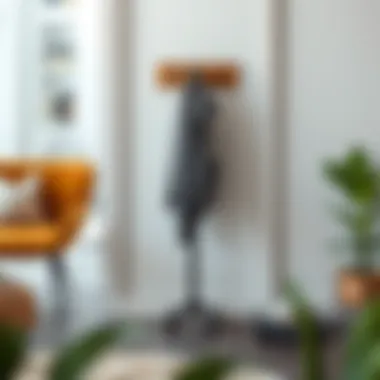

Remember: The right coat stand can be a beautiful blend of function and fashion, elevating your entryway to new heights.
Current Trends Influencing Coat Stand Design
In today’s fast-paced world, coat stands are evolving beyond mere utility. Their design now reflects an understanding of how our living spaces can blend style and functionality. As we delve into this topic, it’s crucial to recognize two prominent trends shaping the modern coat stand: the move towards sustainable materials and the integration of technology. These trends not only address environmental concerns but also cater to the growing demand for multifunctional, aesthetically pleasing home furniture.
Sustainable and Eco-Friendly Materials
As more people become aware of climate change and environmental issues, using sustainable materials in interior design is increasingly important. Modern coat stands are often made from materials that are renewable, recycled, or repurposed. Choices like bamboo, reclaimed wood, or even recycled metal not only reduce waste but also add unique character to each piece.
- Bamboo: This rapidly growing plant is a fantastic choice for eco-conscious consumers. Light, strong, and highly sustainable, bamboo coat stands can bring a natural element into your home.
- Reclaimed wood: Each piece tells a story. When a coat stand is anchored in history, it becomes more than just furniture; it adds a narrative to your interior.
- Recycled metals: These materials are durable and can withstand the test of time, making them a solid investment.
"Using eco-friendly materials is like giving your home a breath of fresh air, aligning aesthetics with responsibility."
The rise in popularity of these materials supports not just a new trend but a broader movement toward responsible consumption. Homeowners are now seeking not just to decorate but to do so consciously, leading to brands that prioritize eco-materials gaining traction in the market. This shift encourages manufacturers to innovate, resulting in beautiful designs where function meets environmental mindfulness.
Smart Coat Stands: Technology Integration
Technology is permeating all facets of our lives, and home furnishings are no exception. The advent of smart home technology has prompted a transformation in traditional coat stands, integrating them with unique features that enhance user experience. Imagine a coat stand with built-in sensors that detect humidity and temperature—ideal for caring for delicate fabrics or outerwear.
- Bluetooth connections: Some modern coat stands come equipped with speakers or charging docks that allow for a seamless blend of utility and entertainment. Picture grabbing your coat while your favorite music plays—talk about multitasking!
- Lighting integration: Built-in LED lights can not only serve as functional lighting but can create an inviting atmosphere. These stands can be controlled via smartphone apps to adjust brightness based on mood or time of day.
- Health-monitoring features: New tech even looks to track your everyday habits—imagine a coat stand that reminds you when you’re wearing the same coat too often! This kind of integration promotes a thoughtful approach to clothing choices and encourages people to make the most of their wardrobes.
Incorporating such technology into the coat stand design showcases the versatility of this essential furniture piece and its adaptability to modern lifestyles. As we move forward, these trends will likely gain momentum and inspire even more imaginative designs in coat stands to come.
Maintenance and Care for Coat Stands
Taking care of your coat stand might not seem like a priority, but it is an essential part of keeping your home organized and stylish. Maintaining a coat stand not only prolongs its lifespan but also enhances the overall aesthetic of your entryway or mudroom. Just like tending to a garden, regular maintenance goes a long way in ensuring everything looks fresh and functional. A neglected coat stand can lead to scuffs, scratches, and an unkempt look, making your well-curated space feel less inviting.
Addressing the maintenance of your coat stand involves a few considerations, such as the material it’s made from and how heavily it’s used. A sturdy, well-maintained coat stand can hold various items, not just coats, effectively supporting your organizational efforts. Let’s delve into some specific cleaning methods tailored to different materials followed by how to prevent damage, keeping your coat stand in prime condition.
Cleaning Tips for Different Materials
Each material harbors unique cleaning requirements. Here are some tailored tips to keep your coat stand looking sharp:
- Wood: Regular dusting with a soft cloth is a must. For deeper cleaning, use a damp cloth (not soaking wet) to wipe down surfaces, then dry immediately to prevent warping. Consider applying a wood conditioner every few months for added shine and moisture protection.
- Metal: Metals can accumulate dirt and grime. Wipe with a mild detergent solution using a soft cloth. Avoid harsh chemicals which may cause corrosion. For stainless steel or chrome finishes, a little vinegar or baking soda can work wonders.
- Combination Materials: If your coat stand features mixed materials, start with the most sensitive parts. Generally, cleaning with a mild soap and water solution followed by a thorough drying is the safest route. Always check the manufacturer’s care instructions, if available.
"A little care today can save you from a headache tomorrow."
By making cleaning part of your routine, you preserve not just the functionality but the visual appeal of your coat stand.
Preventing Damage and Wear
To prevent wear and tear on your coat stand, consider these practices:
- Avoid Overloading: It’s tempting to hang all your winter coats on the stand, but overloading can result in breaking. Try to distribute the weight evenly and consider having designated spots for heavier items.
- Mind the Elements: If your coat stand is situated near the front door where it’s exposed to moisture or harsh sunlight, think about moving it or protecting it with a cover. Dampness can promote mold on wood, while sunlight can fade colors.
- Routine Checks: Inspect your coat stand for any loose screws or wobbling parts every few months. Tightening components can prevent bigger issues down the line.
- Use Protective Bases: If necessary, place felt pads under the feet to prevent scratching your floors and to offer stability.
These precautions help ensure that your coat stand remains a valuable part of your home's organization without succumbing to everyday wear and tear.
The Future of Coat Stand Design
The way we approach home organization is evolving, and with that, the design of everyday items, such as coat stands, also transforms. As homes become more multifunctional, coat stands are now seen as not just functional furniture, but also as integral elements enhancing the overall aesthetic. The future of coat stand design reflects this trend, indicating that practical and stylish elements are increasingly intertwined.
In this evolving landscape, a few key aspects stand out. First, there is a pronounced need for adaptability. Space constraints in modern living environments, particularly in urban areas, make it crucial for coat stands to function efficiently, serving multiple purposes while occupying minimal space. Furthermore, the rise in interest surrounding sustainable materials means that many designers are looking for eco-friendly alternatives. Concerns about environmental impact are pushing the industry to innovate further.
Keeping these elements in mind will help homeowners, designers, and retailers recognize the coat stand’s potential as a statement piece. As we explore innovative concepts and integration within modern interiors, it’s clear that the future is about merging practicality with artful design.
Innovative Concepts on the Horizon
As we look ahead, technology will play a significant role in shaping the future of coat stands. Imagine a coat stand equipped with wireless charging capabilities, or one that includes built-in speakers for music lovers. Integrating smart technology into coat stands means enhancing their functionality beyond simple storage. This could include motion sensors that illuminate when someone approaches, or even built-in hooks that understand the weight of the coats placed on them, indicating to users how many can be safely hung.
Additionally, modular designs could provide endless adaptability. These stands could be expanded or contracted based on the user’s current needs, whether for a gathering of guests or a quiet day at home. This modular approach not only reflects an understanding of varying lifestyles but also allows users to customize their space without permanent alterations.
"The future of coat stand design will be marked by an intersection of technology and personalization, catering to unique spaces and user preferences."
Integrating Coat Stands into Modern Interiors
Modern design thrives on the ability to blend functionality with beauty. To successfully integrate coat stands into contemporary interiors, one must consider the overall theme of the space. An industrial-style coat stand made of reclaimed wood and metal can serve as a stunning focal point in an urban loft, while a sleek, minimalist option might be more appropriate in a Scandinavian-inspired home.
When selecting a coat stand, it’s essential to think about the color palette and materials already present in the room. A well-placed coat stand can either stand out as a feature piece or blend seamlessly into the background. For example, a bright, eye-catching stand can add a splash of color to a neutral space, while a stand in muted tones can keep the environment serene and organized. Mixing materials, like wood and metal, introduces texture and depth, ultimately creating a more visually appealing environment.





